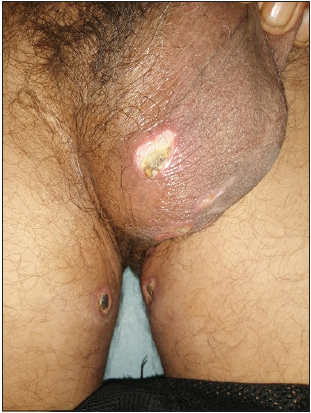Ecthyma grangrenosum: A rare entity to keep in mind
Meryem Khalidi , Mohammed El Amraoui, Naoufal Hjira, Mohammed Boui
, Mohammed El Amraoui, Naoufal Hjira, Mohammed Boui
Dermatology-Venerology Department at Mohammed V Military Hospital of Instruction, Rabat, Morrocco
Corresponding author: Meryem Khalidi, MD
Submission: 02.03.2021; Acceptance: 19.03.2021
DOI: 10.7241/ourd.2021e.50
Cite this article: Khalidi M, El Amraoui M, Hjira N, Boui M. Ecthyma grangrenosum: A rare entity to keep in mind. Our Dermatol Online. 2021;12(e):e50.
Citation tools:
Copyright information
© Our Dermatology Online 2021. No commercial re-use. See rights and permissions. Published by Our Dermatology Online.
Ecthyma gangrenosum (EG) is a severe, life-threatening skin infection that progresses sequentially to a maculopapular rash first, then a hemorrhagic bubble, then to necrotic ulceration surrounded by erythema. EG usually occurs in immunodepressed patients (aplasia secondary to chemotherapy, HIV infection, neutropenia or functional deficit of polynuclear neutrophils, agammaglobulinemia). Rarely, it affects healthy individuals. The differential diagnosis includes leishmaniasis, pyoderma gangrenosum, pressure ulcers and papulonecrotic tuberculids. Blood cultures and / or local sampling can isolate the causative organism which is P. aeruginosa. Treatment is based on parenteral antibiotics adapted to the antibiogram (third generation cephalosporin, fluoroquinolones) [1]. We report the case of a 50-years-old man patient followed for multiple myeloma under chemotherapy protocol who presented with multiple necrotic ulcers located in the scrotum with an erythematous border (Fig. 1), progressing in a feverish context and deterioration of general condition. The biological assessment objectified high VS at 30 mm, a CRP at 80 mg / l. A bacteriological sample of the pus revealed the presence of Pseudomonas Aeruginosa. The diagnosis of ecthyma gangrenosum was made. The patient was put on third generation cephalosporin intravenously. Complete healing with scarring occurred after 4 weeks.
 |
Figure 1: Multiple scrotal ulcers in ecthyma gangronosum. |
Consent
The examination of the patient was conducted according to the principles of the Declaration of Helsinki.
The authors certify that they have obtained all appropriate patient consent forms, in which the patients gave their consent for images and other clinical information to be included in the journal. The patients understand that their names and initials will not be published and due effort will be made to conceal their identity, but that anonymity cannot be guaranteed.
REFERENCES
1. Amatya B, Tripathee RD, Sharma R, Maharjan L. Ecthyma gangrenosum aggravated by systemic antibiotics:A case report and literature review. Our Dermatol Online. 2018;9:27-30.
Notes
Source of Support: Nil,
Conflict of Interest: None.
Request permissions
If you wish to reuse any or all of this article please use the e-mail (brzezoo77@yahoo.com) to contact with publisher.
| Related Articles | Search Authors in |
|
 http://orcid.org/0000-0002-2127-3863 http://orcid.org/0000-0002-2127-3863 http://orcid.org/0000-0001-7687-0158 http://orcid.org/0000-0001-7687-0158 |



Comments are closed.